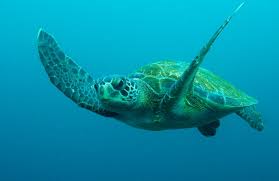CLASSIFICATION OF GREEN TURTLE ( Chelonia mydas )
Anatomy
Green turtles are named for their greenish skin tones. While the shell is usually brown or olive. Green turtle is one of the largest sea turtle species in the world, its weight reaches more than 300 kg. The green turtle has a small head, and can not be pulled into the shell. The shell has a heart-like shape that reaches 1.5 m in length. The shell is wide and has a smooth surface. The male green turtle is slightly larger than the female green turtle. The male green turtle also has a longer tail than the female green turtle. The green turtle has a paddle-like fins, which help it swim strongly and gracefully. These animals usually swim with a speed of 2 - 3 km / hour.
Food
Unlike most sea turtles, green turtles are herbivores (plant-eaters) that eat sea grass and algae (algae) of the sea. But small green turtles eat invertebrates such as crabs, jellyfish, and sea sponges.
Behavior
Most types of sea turtles warm themselves by swimming near the surface of the water. East Pacific green turtles usually go ashore to sunbathe. Not many types of turtles usually go to the mainland except at the time of laying.
Green turtles spend most of their time in the water, but must breathe in the air to do their activities. This animal can inhale and remove the air very quickly to replace oxygen in the lungs. When doing activities, such as foraging, green turtles dive for four to five minutes, and rise to the surface of the water to breathe air for one to three seconds. At rest or sleep, the turtles can hold in water for several hours.
Habitation
Green turtles are in tropical and subtropical coastal waters around the world. These turtles sometimes crawl into the coastal land for sunbathing. There are two types of green turtles, namely the Atlantic Green Turtles that are usually found on the beaches of Europe and North America, and East Pacific green turtles located on the beaches from Alaska to Chile.
Reproduction
The mating period occurs every two to four years. Green turtles, like most types of turtles, migrate away from the feeding places to spawn. The turtles lay their eggs on the mainland of sandy beaches. To lay eggs, female turtles leave the ocean and walk to the mainland to choose a place to spawn in the sand. The bentina turtle will dig a hole in the sand using its fins, then lay the hole for 100 to 200 eggs.
Classification of green turtles as follows:
Kingdom : Animalia
Sub Kingdom : Metazoa
Phylum : Chordata
Sub Phylum : Vertebrata
Class : Reptilia
Sub Class : Anapsida
Ordo : Testudinata
Sub Ordo : Cryptodira
Family : Cheloniidae
Spesies : Chelonia mydas
